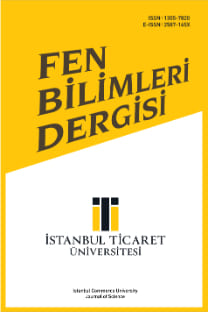TEK MAKİNE ÇİZELGELEME PROBLEMİ İÇİN DAL SINIR YAKLAŞIMI
Çizelgeleme, tek makine, toplam ağırlıklı gecikme minimizasyonu, dal & sınır
A BRANCH AND BOUND APPROACH FOR SINGLE MACHINE SCHEDULING PROBLEM
___
- Atan M. O., Akturk M. S., (2008), Single CNC machine scheduling with controllable processing times and multiple due dates, International Journal of Production Research 46, 6087-6111.
- Baker K. R. and Trietsch D., (2009), Principles of sequencing and scheduling, A John Wiley& Sons Inc, Hoboken, New Jersey, 2009. Batsyn M., Goldengorin B., Pardalos M. Sukhov P., (2014), Online heuristic for the preemptive single machine scheduling problem of minimizing the total weighted completion time, Journal of Optimization Methods and Software, 23(5), 13-17.
- Batun S. and Azizoğlu M., (2009), Single machine scheduling with preventive maintenance, International Journal of Production Research, Vol. 47, No. 7, 1753–1771.
- Benmansour R., Hamid A.& Artiba A., (2012), Stochastic single machine scheduling with random common due date, Journal International Journal of Production Research, Volume 50, 2012 -Issue 13.
- Bülbül K., Kaminsky P., and Yano C., (2007), Preemption in single machine earliness/tardiness scheduling, Springer Science and Business Media, LLC 2007.
- Chang P.C, Chung Y.K., Hsieh, J.C., (2004), On single-machine scheduling with release times to minimize total weighted completion time, Journal of the Chinese Institute of Industrial Engineers, Vol. 21, 567-575.
- Du J., Leung J.Y.T., (1990), Minimizing total tardiness on one machine is NP-hard; Mathematics of Operations Research Vol. 15, No. 3 (Aug., 1990), 483-495.
- Gordon, V., Potapneva E. and Werner F., (1997), Single machine scheduling with deadlines, release and due dates, Optimization, 42, 219-244.
- Gupta J.N.D., & Chantaravarapan S., (2008), Single machine group scheduling with family setups to minimize total tardiness, International Journal of Production Research 46, 1707–1722.
- Hoogeveen J.A., (2005), Multicriteria scheduling, European Journal of Operational Research Volume 167, Issue 3, 16 December 2005, 592-623.
- Lawler E.L., (2005), A “Pseudopolynomial” Algorithm for Sequencing Jobs to Minimize Total Tardiness, Annals of Discrete Mathematics Volume 1, 1977, 331-342.
- Lee W., Shiau Y., Chung Y., and Lawson D., (2014), Single-Machine Scheduling to Minimize Total Completion Time and Tardiness with Two Competing Agents, the Scientific World Journal Volume 2014.
- Lenstra J.K., Rinnooy A.H.G.K., and Brucker P., (1977), Complexity of machine scheduling problems, Annals of Discrete Mathematics, Vol. 1(1977), 343-362.
- Tanaka S., (2012), An Exact Algorithm for the Single-Machine Earliness–Tardiness Scheduling Problem, Just-in-Time Systems, Volume 60 of the series, Springer Optimization and Its Applications, 21-40.
- Yang D.L., Hung C.L., Hsu C.J., Chern M.S., (2002), Minimizing the makespan in a single machine scheduling problem with a flexible maintenance, Journal of the Chinese Institute of Industrial Engineers, 19, 63-66.
- Yurtkuran A. & Emel E., (2016), A discrete artificial bee colony algorithm for single machine scheduling problems, International Journal of Production Research, 54:22, 6860-6878.
- Zhang L., Guan L., Zhou K., (2014), Stochastic Machine Scheduling to Minimize Waiting Time Related Objectives with Emergency Jobs; Discrete Dynamics in Nature and Society, Volume 2014.
- ISSN: 1305-7820
- Yayın Aralığı: 2
- Başlangıç: 2002
- Yayıncı: Doç. Dr. Necip Şimşek
OTOPARK SİSTEMLERİNDE İSTANBUL KART UYGULAMASI İSPARK ÖRNEĞİ
Bahadir GÜLSÜN, Gülbahar ŞAHİN
SAYMA SÜREÇLERİYLE YAŞAM SÜRDÜRME ANALİZİ
TEK MAKİNE ÇİZELGELEME PROBLEMİ İÇİN DAL SINIR YAKLAŞIMI
Sebrina Tadesse DAWD, Berk AYVAZ
TÜRKİYE’DEKİ DOĞAL GAZ TÜKETİMİ VE GRİ TAHMİN METODUYLA TAHMİN EDİLMESİ
